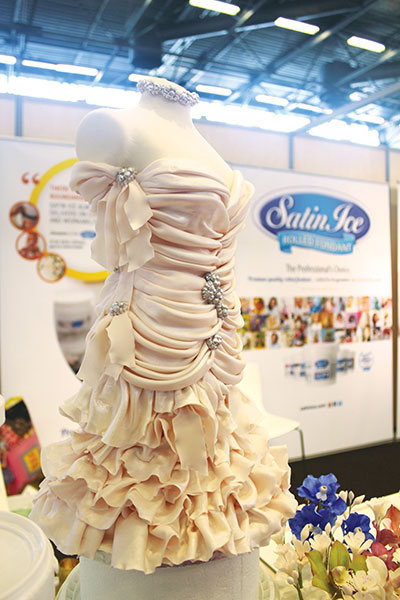
Fondant finances
July 4, 2014
By
Laura Aiken
Fondant can be a lot of fun. It’s like Play-Doh for adults, where your
imagination is the only limit and the results are razzle-dazzle.
Fondant can be a lot of fun. It’s like Play-Doh for adults, where your imagination is the only limit and the results are razzle-dazzle. But, as with all fun and games in baking, it all comes down to finances. Making those pretty cakes just isn’t as much fun if it’s not paying the rent.
 |
|
| A wedding dress as a cake on display at Satin Ice’s Europain booth shows the kind of intricate detail cake the medium affords cake designers, and the resulting wow factor that lets them charge more for the cakes. PHOTO: Laura Aiken |
Fortunately, bakeries can charge a nice premium for fondant-covered cakes. It’s labour intensive, but the results cannot be matched by any other medium. There will always be a place for buttercream or ganache-covered cakes, but they are different end products. Fondant is the only one that offers such limitless design possibilities and the beauty that customers are willing to pay the premium for.
“I’ll always say go find me a product that’s as profitable as a rolled fondant cake,” said Kevin O’Reilly, founder and CEO of Satin Fine Foods, creator of Satin Ice fondant, in conversation with Bakers Journal at this year’s Europain show in Paris. “It will always be the most profitable when you look at the bowl cost and when you look at the selling price of a wedding, custom or special occasion cake. Take an 8-inch round that you cover with buttercream and you can it sell for $13 or $15 dollars. Take the same cake with fondant and you can sell it for $35 or $40 dollars. The cake is the same so you have to really look at it that regard and what the consumer is willing to pay.”
There are several ways to ensure you are maximizing the profit on your fondant cakes. Bakers Journal rounded up some tips from inside a cake shop and on the supply side to help you put the right price on your time and special creations.
Proper pricing
Catherine D’Agostino and Adrienne D’Amico are the business partners behind We Bake in Heels boutique cupcake and cake shop in Vaughn, Ont. After several years in business, they’ve learned a thing or two about the business behind fondant.
For We Bake in Heels, using a high-quality fondant that is properly stored is the first step. The shop portions the fondant by weight to minimize waste. Since spending time on repairs takes a chunk out of labour time, and the women view a less-than-perfect cake as not an option, planning is an essential part of the process.
“It’s very important to have a design, and plan how you are going to carry out that design in order to avoid making mistakes,” the duo shared in an email to Bakers Journal. “Maintaining a neat, organized workspace and taking the time to do nice, clean work also helps a
great deal.”
Technique is also paramount to profit. Satin Fine Foods’ booths are showcases for technique, with cake decorators at work throughout the event. The company hosts more than 50 videos on their website covering basic to advanced skills. To keep costs down, it’s very important to roll fondant to the right thickness, O’Reilly says. Another important key is being able to account for the labour time through planning and price accordingly. It is wise to pay attention to how much time you spend with the bride in your wedding cake business. In O’Reilly’s past life, he spent time selling cakes to brides and worked out a system to keep his time on budget. He typically met with the bride for 25 to 35 minutes. He would ensure they were already settled in and sampling cake when he arrived with his clipboard. He kept the niceties brief, asking how the customer is and when is the big day, before moving quickly into the questions on his clipboard. He would usually sketch the cake during that meeting, but ensure it never topped 40 minutes.
“Many times I’ve talked to a cake artist who says the first meeting is an hour, then they might spend another half hour on phone, then a second or third meeting, and all of a sudden you’ve spent two or three hours of your time and people aren’t calculating that in as far as dollars per hour and including in the cost of the cake.”
At We Bake in Heels, D’Agostino and D’Amico found that developing an average charge per hour or a cake price was helpful to cover minimum costs.
“We didn’t charge a base cake price when we first started, which we learned very quickly was something we needed to do. We also learned never to sell yourself short – that even if you have just started a cake business, you should always charge what you feel your cakes are worth, and remain competitive with your peers in the industry.”
Ensure the budget is on the table during the initial consultation, and that the bakery is realistic with what can be done for the price.
Print this page
Leave a Reply